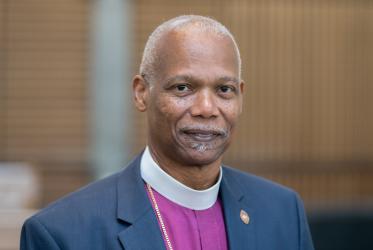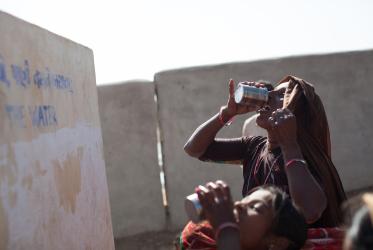Thank you, moderator of the Ecumenical Water Network, asking me to respond to this very specific question, and let’s state it again: Do you see a linkage between the WCC’s water justice campaign and the WCC’s overarching theme of justice and peace?
May I first request that you forgive me for not making a full presentation on the Ecumenical Water Network, due to a number of constraints, but I'll say a few things on this connectivity, or on the link between the two movements.
I do believe that there are links, there are connections between the water justice movement and the overarching theme of justice and peace. As a matter of fact, the water justice campaign is a component of this overarching theme.
You will recollect that after the 2014 Central Committee we were to align our programs to the overarching theme. As well, we can see that both [the] justice and peace [movement] and [the] water justice network accompany people on the margins, where they draw lessons of transforming past experiences and heal present “wounds”.
The central concept, and the operative term in both areas, is justice. It can be economic justice, social justice, political and religious justice, and structures that transcend from just relationships with God, the Creator, and the created nature. Both pilgrimage of justice and peace and the water justice network are movements and momentums that seek to address matters of injustice, oppression inequality, conflict and threats to life.
The seven weeks campaign, held during the Lenten season, have always coincided with the pilgrimage of justice team visits, thereby providing a channel and space for churches, local congregations, communities, and other individuals to relate to the theme of justice and peace in a very concrete way and in a way that resonates with some of their key challenges. Namely, for example, water as a resource that is a must for every community and yet a resource that is not availed to all in a just manner.
This network has inspired green congregations and communities as a measure to address, inter alia, water deficits, water companies that seek to deny the right to water, and just structures and systems governing most of the countries in the Global South. For instance, water distribution systems tend to be biased against the poor. Justice and peace communities witnessed how water systems prioritize private companies, such as flower companies, and the rich, at the expense of vulnerable and communities on the margins of societies.
A very good example, in most of our continents, is the informal settlements, or what the Latin Americans call favelas, and it's a wonder, in fact it is a miracle that people grow, survive under these conditions.
The unjust water systems and the inequitable use that favours companies, the very ones that pollute rivers, seas, lakes, and destroy the environment, thus resulting in demonstrations by communities against them as their habitat becomes inhabitable. Oil fields, places where extractive industries are operating, have become “death fields” rather than “life fields”.
The quality of water, that poor people access, if at all they do, is, in most cases, a cause for waterborne diseases. Moreover, scarcity or lack of water has increasingly been a factor in communion conflicts and tensions, as well as states. Take for example the Nile River, which engulfs a number of states who are constantly in tension over this vital resource.
Another area of water-related conflict is between pastoralists and farmers due to the desertification as pastoralists search for pasture and water. Their animals inevitably tend to cross into agricultural fields.
Indeed, the water justice network is in the business of ensuring that communities and nations heal as it is told in Revelations 22:2: “The leaves of a tree are for the healing of a nation.” The question that the network has constantly been raising is: how can nations heal when forces of death are destroying life, human life, natural habitat, for example, water resources and vegetation. How will communities heal from trauma and historical wounds when their testimonies lean towards a cry to resolve the dry rivers, the diminishing biodiversity, which is supposed to provide medicine and food.
Therefore, the Ecumenical Water Network is touching on broader issues of justice and peace. The conflicts I mentioned tend to undermine any socio-economic development and security as the state of peace is replaced by the architecture of insecurity.
At the heart of the Pilgrimage of justice and peace theme is celebration, restoration, and protection of life as forces of death are exposed, forces of injustice and conflict are overcome. The theme also inquires into the resilience of people in the midst of such diversity. Where else would that resilience be seen more than in the area of water when communities go to great length to look for alternative water resources.
Life is a God-given gift and it is to be lived, celebrated and enjoyed by all people, irrespective of the gender, nationality, race, and religion.
The centrality of the concept and the sanctity of life echoes the essence of water as a key resource. Water is indeed life and without water life has no chance of fully thriving, let alone growing. Pilgrimage of justice and peace and the Ecumenical Water Network are foundational to human dignity and human rights. Both justice and peace and water justice have been moments of awakening collective consciousness and sharing knowledge on the limited nature of resources, such as water, and hence the need to be cautious when we use these resources and to find means and ways of restoring what we have used.
Both justice and peace, and the Ecumenical Water Network have spirituality and theological reflections as an embodiment of the movements. Water as a critical resource for existence and God's imperative for justice are core to both components. This is aptly captured in the book of Amos 5:24, when it says, “Let justice run down like water, and righteousness like a mighty stream.”
You will all recollect that in traditional societies the art of drawing water, of fetching water, is a together affair, and its use is both individual and collective. Justice and peace and water justice reached out to policy-makers although companionship and accompaniment has largely focused on vulnerable and poor communities.
To conclude, it is clear that water justice is a central component of justice and peace. The campaign has been a reminder of our stewardship role of nature and humanity, that societies grow and prosper when the foundations, systems, structures, and policies are formulated and implemented in a manner sensitive to the least and weak members, and more important when natural resources are understood not to be unlimited but requiring replenishing and careful use.
Let us build therefore, blue and green family homesteads, blue and green communities, blue and green churches, blue and green countries. Continue to meditate and reflect on relevant solutions in our context today which is informed largely by the pandemic. Can we lift up the spirituality of needs and not spirituality of wants?
Remember, the Lenten season has been, since the launch of justice and peace and the Ecumenical Water Network, a centrality of Christ giving up his life for our sake. A centrality of the theme of life, that shows how Christ’s love transcends any barrier. May God bless us as we move forward and as we celebrate the gift of water.
Thank you.




